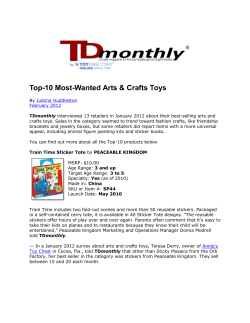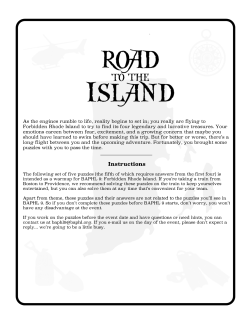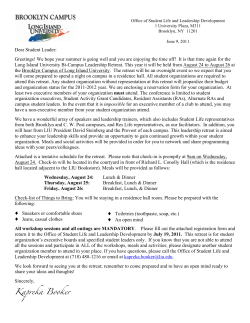
Kingdom READING ZONE Kensuke’s teacher’s resources
5th class Novel notes: War Horse teacher’s resources Kensuke’s Kingdom Michael Morpurgo Roald Dahl NOVEL NOTES 4TH CLASS READING ZONE English Language Programme for Primary Schools 1 Novel Notes Kensuke’s Kingdom © 2012 Folens Publishers First published in 2012 by: Folens Publishers, Hibernian Industrial Estate, Greenhills Road, Tallaght, Dublin 24 Folens books are protected by international copyright laws. All rights reserved. The copyright of all materials in this book, except where otherwise stated, remains the property of Folens Publishers. No part of this publication may be reproduced, stored in a retrieval system or transmitted in any form or by any means (stencilling, photocopying, etc.) for whatever purpose, even purely educational, without the prior written permission of the publisher. The publisher reserves the right to change, without notice, at any time the specification of this product. The publisher has made every effort to contact copyright holders but if any have been overlooked we will be pleased to make any necessary arrangements. To the best of the publisher’s knowledge, information in this book was correct at the time of going to press. No responsibility can be accepted for any errors. Contents Synopsis 1 About the Author 2 Objectives 2 Cross-curricular Links 3 Suggestions for Classroom Work 3 Web Links 4 Pre-reading Activities 4 Chapter 1 6 Chapter 2 7 Chapter 3 8 Chapter 4 9 Chapter 5 10 Chapter 6 11 Chapter 7 12 Chapter 8 13 Chapter 9 14 Chapter 10 15 Post Script 16 Book Report Sheet 17 Link to Reading Zone. The Golden Harp: Unit 28 – Seán McSharry Climbs Over the Clouds Kensuke’s Kingdom Kensuke’s Kingdom Synopsis T he narrator of the story, Michael, is a young adult remembering events that happened to him as a boy. Aged 11, he lived in a town in England with his parents and his dog, Stella Artois. His family’s happy life is completely changed when both his parents are made redundant from the local brickworks. After finding no other job prospects at home, his father decides to use their small savings to buy a yacht, called the Peggy Sue, and sail around the world with his family. They train for several months and set sail on their adventure. Michael’s family take on many daily jobs to keep the yacht going. As well as helping out with the boat, Michael studies his schoolbooks, and notes down what he sees around him in his own personal log book. After travelling to Brazil, Cape Town and Australia the family sail towards Papua New Guinea. One night, as his parents sleep below deck, the boat veers suddenly and Michael and his dog are thrown into the sea. Michael clings to his football to avoid drowning but loses consciousness. He wakes up on what he discovers to be a small island, populated by gibbons and orang-utans. His attempts to survive there are helped by an anonymous benefactor who leaves food and fresh water by the cave where he and his dog sleep at night. Michael decides to light a big fire on the beach to alert passing boats to his whereabouts, hoping that his family are looking for him. He discovers an old man, who calls himself Kensuke, putting out the fire. Kensuke speaks very little English. Kensuke angrily forbids Michael from lighting fires and makes him stay on one side of the island only. Kensuke also forbids Michael from swimming in the sea. Eventually, when he spots a Chinese sailing ship, Michael lights a bigger fire on a hill in defiance of Kensuke’s wishes. Kensuke again puts out the fire. In a rage, Michael runs into the sea to swim toward the ship and is severely stung by a jellyfish. Kensuke saves Michael and nurses him back to health in his cave house. The cave house is neatly equipped with many salvaged items and built furniture. The two become friends and Kensuke teaches Michael how to paint and fish. Taking Michael out to fish on his outrigger boat, Kensuke tells the story of how he came to the island. A Japanese doctor from Nagasaki, he trained in London and joined the Japanese navy on a warship. He was the sole survivor of a shipwreck after the warship was bombed. Upon overhearing some US soldiers talk about the nuclear bombing of Nagasaki, Kensuke gave up all hope of his wife and son being alive and decided to stay on the island for good. He learned to survive by observing and befriending the orang-utans. He salvaged what he could from the wrecked ship. Kensuke reveals that he rescued Michael from the water on the night he fell overboard. Over time, the old man realises that Michael misses his family and agrees to make a new fire to signal for help. Kensuke decides that if a boat comes along he will leave the island with Michael and return to Japan. However, the island is attacked by gibbon poachers and it makes Kensuke realise that he must stay to protect his ‘kingdom’. When they spot a boat on the horizon, they light the beacon fire. The boat is the Peggy Sue, and Michael is reunited with his parents after making a promise to Kensuke that he will not reveal his existence on the island until at least ten years have passed. In a postscript, it is revealed that Kensuke’s son and wife survived the Nagasaki bombing, and Michael has a meeting with Kensuke’s son. Issues and themes explored in this novel include poverty, war, violence, exploration, loneliness and survival. 1 4th Class Novel Notes About the Author ichael Morpurgo was born in St Alban’s, England in 1943. He is a poet and playwright but is best known as a writer of children’s books. He is married with three children. Morpurgo was educated in English schools including boarding schools which would influence the writing of The Butterfly Lion. He went on to study English and French at London University and became a primary school teacher. His first book was published in 1974. He has written over 120 books, including Waiting For Anya, The Butterfly Lion, War Horse, Kensuke’s Kingdom and Private Peaceful. He held the title of Children’s Laureate from 2003 to 2005. He has been shortlisted for the Carnegie Medal four times and his children’s books have won the Whitbread Children’s Book Award, the Smarties Book Prize and the Red House Children’s Book Award. His novel War Horse has been adapted into a film directed by Steven Spielberg. Objectives Curriculum Objectives The child should be enabled to identify unfamiliar words by reference of word parts, prefixes and suffixes; understand the relationship between text and illustration; become an increasingly independent reader; engage in talk about the book; using simple dictionaries effectively; using information technology to increase motivation and to enhance reading achievement. Learning Outcomes 2 Record events in the story by keeping a reading log. 2 Write ship’s log entries as Michael from various points in the narrative. 2 Write a newspaper account. 2 Write an alternative ending to the story. 2 Create a character profile. 2 Create an advertisement. 2 Read other books and stories on shipwrecks or survival. 2 Participate in a class discussion / brainstorm. 2 Kensuke’s Kingdom Cross-curricular Links SPHE Different feelings and emotions such as anger, grief, sadness, happiness, fear, worry, and loneliness can be explored. What role does hope play in our lives or in the lives of the characters in the story? What happens when people lose hope? How do they get it back? Discuss the importance of friendships in the book; between Michael and Eddie, between Michael and Kensuke and between Kensuke and the orang-utans. The effects of unemployment and poverty on the family at the beginning of the story can also be looked at. Gaeilge Children could perform a simple Irish language role-play of Michael’s first meeting with Kensuke. It is light on dialogue but individual Irish words could be used to express what both characters want to say. Visual Arts Draw and paint a map of the island referring to the description from the book only and not the map from the book itself. Alternatively or additionally, a painting or model could be made of the interior of Kensuke’s cave house. Drama There are many dramatic moments in the book which would serve well as short acted scenes. Orang-utan characters are a great excuse to use mime. The scene where the family rescue Stella Artois from drowning, the scene where Kensuke puts out the hilltop fire as Michael pleads with him that he wants to return home, or the scene where Kensuke and Michael must gather the orang-utans before the poachers land on the island, could all work well. History As a background exercise, touch briefly on WW2 in Japan and the bombings of Nagasaki and Hiroshima. Napoleon’s life and exile to St Helena can also be discussed from earlier in the book. More generally, explore the impact of World War Two on the lives of everyday people caught up in the conflict. Geography The book presents a good opportunity to develop map skills. Using the map illustrations in the book, locations can be found on other, more detailed maps to gain appreciation of the distance travelled by Michael’s family and the time each leg of the voyage took. The book illustrations also explain some of the prevailing winds that allow yacht sailing around the world which facilitates further class discussion on trade winds and westerly/easterly winds, etc. Digital maps allow for the journey to be followed, showing satellite views of story locations such as Rio de Janeiro, Cape Town and Perth. A study of the people and customs of Japan is very relevant to this story. Brainstorm the word ‘Japan’. Discuss how Japanese customs are represented by Kensuke’s way of life and worldview. Suggestions for Classroom Work 2 Keep a reading log for every chapter. 2 Let children imagine that Michael still has his ship’s log book and pens with him on the island. Give children different days from the book to write entries for. These can be illustrated with pencil drawings and sketches just as Michael did. 3 4th Class Novel Notes 2 Write a newspaper account of Michael’s family returning to England. Choose an appropriate headline. Alternatively or additionally, write a newspaper report from a Japanese newspaper reporting the meeting between the adult Michael and Kensuke’s son Michiya. 2 Children could write an alternative ending to the story, with Kensuke returning to Japan to find his son and wife still living. 2 Create a character profile for Kensuke or either of Michael’s parents. 2 Imagine that the Peggy Sue is available for hire. Write an advertisement to show the features of the boat and where it has been. Illustrate the advertisement. 2 Find out what happens in other stories of shipwreck and survival such as Robinson Crusoe and Swiss Family Robinson. Web Links A site which explains how a sailboat works: http://adventure.howstuffworks.com/outdoor-activities/water-sports/sailboat.htm A short interview with Michael Morpurgo about the book: http://michaelmorpurgo.org/books_kensukes_kingdom.html A mural based on the book: http://www.darkstar1.co.uk/andykensukemural.htm Longer interview with Michael Morpurgo: http://www.guardian.co.uk/books/childrens-books/2011/mar/02/michael-morpurgo-interviewchildren Explore Japan page: http://web-japan.org/kidsweb/explore/index.html Pre-reading Activities Oral Pre-reading Questions Chapter 1 Look at the map at the start of this book. What does it tell you about the kind of book this might be? 4 Chapter 2 How do you think the family will find living on a yacht out at sea? Kensuke’s Kingdom Chapter 3 After reading the last page of Chapter 2, explain why you might expect the next chapter to look a little different. Chapter 4 Do you think the boy can survive the accident? Do you think Stella can survive? Chapter 5 What do you think this old man is going to say to Michael? Chapter 6 ‘Abunai’ is the Japanese word for danger. Do you think something dangerous could happen in this chapter? What? Chapter 7 Is the boy in greater danger now than when he fell overboard from the Peggy Sue? Why? Chapter 8 The old man has said he might do something while they are out fishing on the outrigger. What was it? Could the title of this chapter have something to do with that? Chapter 9 How do you think Kensuke will react to finding Michael’s message in the bottle? Chapter 10 What does the title of this chapter tell you about what might happen next? Vocabulary Pre-teach the relevant new vocabulary in each chapter. A glossary of Japanese terms used is provided in most editions at the end of this book. Children may wish to be informed of this glossary to refer to before they read Chapter 4 onwards or it might be used to illuminate sections of the book only upon completion of the novel. Several sailing terms crop up throughout the text which may be unfamiliar to children. Add new words to the word wall, ask the students to use new words in a sentence, get the children to think of words that mean the same thing as the new words (synonyms), etc. Kensuke’s Kingdom : Comprehension Chapter1 Activity sheet Comprehension Activity Sheets Presented over the following pages are a selection of both lower and higher order questions for each section of this novel, which the teacher may choose from. 1 1. What does the title Activity Sheet 1 ‘Peggy Sue’ ‘Peggy Sue’ refer to? 2. What is the narra tor saving up to buy with his pape round money? r 3. How does life change for the fami ly after the letter com es? 4. Why does the boy’s grandmother think that the sailin is a bad idea? g trip 5. Write a few lines that you think the boy might have writt ship’s log on Sept en into the ember 10, 1987 to remind him of the day. 6. Imagine that you are the boy’s best friend, Eddi you’ve just heard e Dodds, and that your friend is planning to sail world. Describe around the how that makes you feel. 7. This chapter contains some word s related to sailin dictionary, find out g. Using a what the following words mean: 1) skipper, 2) winc hes and 3)galley . 6 NAME: Photocopiables © Folens DATE: 5 Kensuke’s Kingdom: Comprehension Activity Sheet 1 Activity sheet Chapter 1 ‘Peggy Sue’ 1. What does the title ‘Peggy Sue’ refer to? 2. What is the narrator saving up to buy with his paper round money? 1 3. How does life change for the family after the letter comes? 4. Why does the boy’s grandmother think that the sailing trip is a bad idea? 5. Write a few lines that you think the boy might have written into the ship’s log on September 10, 1987 to remind him of the day. 6. Imagine that you are the boy’s best friend, Eddie Dodds, and you’ve just heard that your friend is planning to sail around the world. Describe how that makes you feel. 7. This chapter contains some words related to sailing. Using a dictionary, find out what the following words mean: 1) skipper, 2) winches and 3) galley. 6 NAME: Photocopiables © Folens DATE: Kensuke’s Kingdom: Comprehension Activity Sheet 2 Chapter 2 1. Name three types of sea creatures that the boy sees from the yacht. Activity sheet Activity sheet ‘Water, water, everywhere’ 2. What do the family do when the storm dies down and the sun comes out? 2 3. Why is Stella Artois the family’s greatest comfort at sea? 4. Name five of the daily jobs that the boy helps to do on board the yacht. 5. Which of the subjects that the boy has to study would you most like to study? Why? 6. What kinds of things do you think you would record in your own log book if you were at sea for many months? NAME: Photocopiables © Folens DATE: 7 Kensuke’s Kingdom: Comprehension Activity Sheet 3 Activity sheet Chapter 3 ’Ship’s log’ 1. The picture of the ship’s log names the English town that the family set out from. What is it called? 2. What does the boy find out about the island of Saint Helena? 3 3. What rule does the boy’s mother put in place to keep Stella safe? 4. Write a few lines that the boy could have written in one of the funny ‘animal cards’ that he sends to his friend Eddie from Australia. 5. What do you think the boy’s parents might have done and said when they wake up to find him missing from the boat? 6. The boy is in great danger at the end of this chapter. Contrast this accident with the happiest time he has had on their yacht trip. When do you think that was? 8 NAME: Photocopiables © Folens DATE: Kensuke’s Kingdom: Comprehension Activity Sheet 4 Chapter 4 ’Gibbons and ghosts’ Activity sheet 1. Why does the boy sing to himself as he floats in the sea? 2. How does the narrator describe the island? 3. What comforting memory helps the boy to sleep in the cave? 4 4. After eating the meal that has been left for him, the boy scans the forest for any sign of his ‘benefactor’. What do you think this word means? 5. Describe how you would feel if you saw an orang-utan coming towards you on a beach. What would you do? 6. Do you think Michael has taken some good steps to help his survival? Why? NAME: Photocopiables © Folens DATE: 9 Kensuke’s Kingdom: Comprehension Activity Sheet 5 Activity sheet Chapter 5 ‘I, Kensuke’ 1. Why does the old man draw a map of the island in the sand? 2. What is Michael’s favourite of the foods that the old man leaves for him? 3. Name two things that Michael does to help ease his sunburn. 5 4. If you went on holiday what could you do to prevent being bitten by mosquitos? 5. Imagine that you have to spend the night in a cave. What three luxury items would you bring with you, if you could? 6. How do you think Michael will react to the sighting of the ship at the end of this chapter? 10 NAME: Photocopiables © Folens DATE: Kensuke’s Kingdom: Comprehension Activity Sheet 6 ‘Abunai!’ Chapter 6 Activity sheet 1. Who is the first to discover Michael’s secret beacon? 2. Why does Michael spend most of the day lying in the sea? 3. The old man has now forbidden Michael to do three things on the island. What are they? 4. Michael thinks he detects a ‘flicker of understanding’ on the old man’s face after he puts out the fire. What do you think the old man understands? 6 5. How does Michael express his anger towards the old man for putting out his beacon fire? 6. Have you ever been stung by an insect, plant or jellyfish? Describe how it happened and how it felt. NAME: Photocopiables © Folens DATE: 11 Kensuke’s Kingdom: Comprehension Activity Sheet 7 Activity sheet Chapter 7 ‘All that silence said’ 1. Why does the narrator call the old man his ‘saviour’? 2. Name five useful items that Kensuke keeps in his cave. 3. What achievement gives Michael ‘the best feeling in the world’ in this chapter? 4. What does Kensuke use to make his paintbrushes? 5. Write down three questions that you would like to ask Kensuke if you were Michael. 7 6. If you were on the island, what song do you think you could teach Kensuke to sing in order to make him laugh? 7. Why do you think Kensuke keeps his outrigger boat so well hidden? 12 NAME: Photocopiables © Folens DATE: Kensuke’s Kingdom: Comprehension Activity Sheet 8 ‘Everyone dead in Nagasaki’ Chapter 8 2. Why does Kensuke think that his wife and son are now dead? Activity sheet 1. What was Kensuke’s job before he lived on the island? 3. Why did Kensuke not want to see people ever again before Michael arrived on the island? 4. Michael thinks he smells vinegar when he first wakes in Kensuke’s cave after being stung by the jellyfish. What do we find out about it here? 5. Does Kensuke’s story in this chapter change how you feel about him? How? 6. If you could add three more lines to Michael’s note in the Coke bottle, what would they be? 8 7. Why do you think Michael is wracked with guilt about putting the message in the bottle? NAME: Photocopiables © Folens DATE: 13 Kensuke’s Kingdom: Comprehension Activity Sheet 9 Activity sheet Chapter 9 ‘The night of the turtles’ 1. Name three things that change between Michael and Kensuke as a result of the message in the bottle. 2. What lesson does Kensuke learn that helps him to better understand how Michael is feeling? 3. Michael feels a ‘weight of guilt’ on his shoulders after Kensuke finds the bottle. Write about a time when you felt guilty about something. How did you overcome it? 4. What two things does Kensuke plan to do with Michael after their chat in the cave? 5. Why do they only go fishing in the outrigger once in a while? 6. Why do Kensuke’s paintings of cherry trees remind him of his sister? 9 7. In the story, Michael came to the island in 1988. What things from everyday life in today’s world would you tell Kensuke about to amaze him? 14 NAME: Photocopiables © Folens DATE: Kensuke’s Kingdom: Comprehension Activity Sheet 10 ‘Killer men come’ Chapter 10 Activity sheet 1. Why are the faces of Kensuke’s wife and son ‘indistinct’ in his shell portraits of them? 2. What is the first painting of Michael’s that Kensuke stores in his chest? 3. Why does Kensuke not light the beacon to alert the junk boat? 4. What are Kensuke and Michael looking for on the beach when they see the Peggy Sue? 5. Read the opening two paragraphs of Chapter 1 again. Did Michael keep Kensuke’s secret? 6. Imagine there is a newspaper story about Michael’s adventure when he gets back to England. What would be a good headline for it? 7. Write down five words to describe how you think Michael’s parents feel when they see him on the beach. 8. If Kensuke had watched Michael as he left the island on the Peggy Sue, describe some of the thoughts he may have had. NAME: Photocopiables © Folens DATE: 10 15 Kensuke’s Kingdom: Comprehension Activity Sheet 11 Activity sheet Post Script 1. How does the letter from Michiya at the end of this book make you feel? Why? 2. How did Kensuke’s wife and son survive the bombing of Nagasaki? 3. Imagine a different postscript to end the book, where the adult Michael returns to the island. What would he find there, do you think? 11 16 NAME: Photocopiables © Folens DATE: Book Report Sheet If you don’t have enough space to write your answers, use the notes section on the following pages. Pupil’s name: Title of book: Class: Author: Date: Illustrator: book report sheet Setting (where the story took place): List the main characters: 1. 2. 3. 4. This book was: Exciting Boring ( tick all that apply) Interesting Slow-moving Imaginative Fast-paced Amusing Describe your favourite character: Describe your favourite part of the story: Scary Complicated Did you like the book? Why?/Why not? Grade the book ( Easy to read Tick one) Just right Rate the book out of ten: A little difficult Difficult /10 17 Photocopiables © Folens Kensuke’s Kingdom: Notes Notes Notes 18 NAME: Photocopiables © Folens DATE: Kensuke’s Kingdom: Notes Notes Notes NAME: Photocopiables © Folens DATE: 19
© Copyright 2025










